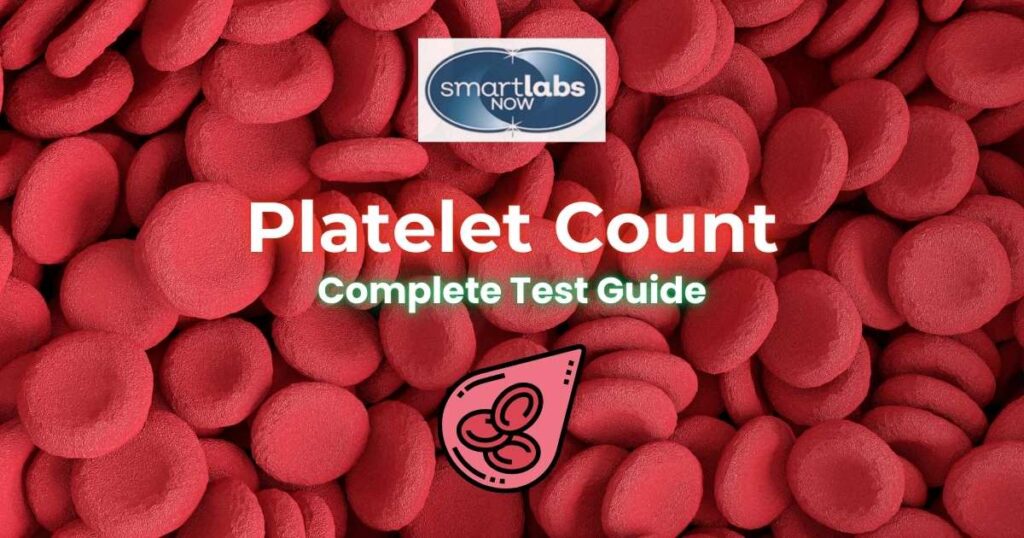
Platelet count testing is essential for assessing blood health, particularly its ability to clot and respond to injuries. Platelets, also known as thrombocytes, play a critical role in clot formation, healing wounds, and preventing excessive blood loss. When your doctor recommends a platelet count test, they’re looking to understand if your blood can clot effectively, a factor that a variety of health conditions can influence.
This test often comes as part of a Complete Blood Count (CBC), which is a common lab test that measures different components of blood, including red and white blood cells, hemoglobin, hematocrit, and platelets.
By examining these elements, healthcare providers can gain insight into overall health, identify potential clotting disorders, and detect underlying health problems.

A platelet count test determines whether you have a normal, high, or low number of platelets, helping to identify the presence of blood disorders, autoimmune diseases, or potential reactions to medications. Platelet disorders can range from thrombocytopenia (low platelet count) to thrombocytosis (high platelet count), each with its own set of symptoms and health risks.
Typically, blood is drawn by a phlebotomist, who collects a blood sample from a vein using a needle. The sample is then examined in a lab, where a CBC or specialized platelet tests like a peripheral blood smear are conducted to reveal the count and characteristics of platelets. Additionally, measurements such as mean platelet volume (MPV) can indicate the average size of platelets, providing further information about blood health and potential issues.

Several factors can lead to abnormal platelet counts. The causes of high and low platelet levels vary, and each may indicate distinct health conditions.
Thrombocytopenia can arise due to conditions that suppress bone marrow production or destroy platelets. Some common causes include:
Thrombocytosis, or elevated platelet count, can result from conditions that stimulate platelet production:
Understanding the cause of an abnormal platelet count is crucial for effective treatment and ongoing health management.

Abnormal platelet levels can present with various symptoms and require careful monitoring.
Low platelet counts can lead to spontaneous bleeding, which may manifest as easy bruising, nosebleeds, or prolonged bleeding from cuts. In severe cases, thrombocytopenia can cause bleeding in the gastrointestinal tract or even life-threatening internal bleeding. Other symptoms might include:
High platelet counts can increase the risk of clot formation, which may lead to serious conditions like deep vein thrombosis or venous thromboembolism. Symptoms include:
For individuals with known platelet disorders, regular monitoring through periodic CBC tests and peripheral blood smears is essential. Certain age-related changes and medication side effects can also impact platelet levels, requiring routine checks for accurate tracking.

Abnormal platelet levels can lead to various complications.
Low platelet counts heighten the risk of chronic bleeding and hemorrhage. Even minor injuries can lead to excessive blood loss. In more severe cases, platelet transfusions might be necessary to manage bleeding risks. Spontaneous bleeding poses significant dangers, particularly if it occurs in the brain or digestive tract.
Thrombotic Thrombocytopenic Purpura (TTP) is a rare but serious blood disorder characterized by very low platelet levels. These levels can lead to abnormal blood clot formation in small blood vessels throughout the body. If not treated promptly, these unexpected clots can block blood flow to vital organs, causing potential organ damage and creating a life-threatening emergency.
One of the primary signs of TTP is the appearance of petechiae—small, pinpoint red or purple spots under the skin that result from bleeding in capillaries. Larger bruises, known as purpura, may also appear, especially on the legs and arms. Additional symptoms often include fatigue, fever, and confusion due to restricted blood flow to organs, as well as pain in the abdomen or chest.
TTP typically arises due to an autoimmune response in which the immune system mistakenly targets an enzyme responsible for preventing clotting in small blood vessels. This immune attack can lead to uncontrolled clotting throughout the body. In rare cases, TTP may also be inherited due to genetic mutations. Although TTP can occur in people of any age or geographic location, certain factors like pregnancy, infection, or certain medications may trigger the onset of the condition.
Diagnosing TTP requires a thorough clinical evaluation, including a blood test to measure platelets and detect the presence of abnormal clotting activity. TTP can sometimes be mistaken for other clotting disorders, such as disseminated intravascular coagulation (DIC), which also involves widespread clotting in small vessels but differs in its causes and treatment approach. Imaging studies or organ function tests may be ordered to assess the extent of any organ damage due to restricted blood flow.
Given the high mortality rate associated with untreated cases, immediate treatment for TTP is essential. Plasma exchange therapy, where a patient’s plasma is removed and replaced with healthy donor plasma, is the frontline treatment for TTP. It aims to remove the antibodies attacking the clot-preventing enzyme.
In severe cases, medication that suppresses the immune system may be required to reduce antibody production. If TTP recurs or proves unresponsive to plasma exchange, spleen removal (splenectomy) may be considered, as the spleen is involved in antibody production and platelet storage.
Patients diagnosed with TTP often require ongoing monitoring and regular blood tests to track platelet levels and ensure the disease remains under control. Lifestyle adjustments, such as avoiding medications that increase bleeding risk, are often recommended.
Elevated platelet counts increase the risk of blood clots, leading to conditions like deep vein thrombosis (DVT) or venous thromboembolism. In some cases, a splenectomy (surgical removal of the spleen) or medication to prevent clot formation may be required to manage symptoms and reduce risk.

Preparing for a platelet count test is straightforward. While fasting is generally not required, your healthcare provider may recommend avoiding certain medications that could influence your blood’s clotting ability.
During the test:
In addition to standard CBC sampling, automated hematology instrumentation is used for accurate, quick platelet counting.

Interpreting results from a platelet count test requires understanding the reference range for platelet counts, which is typically between 150,000 and 450,000 platelets per microliter of blood. Results outside this range may indicate underlying health issues.
Platelet counts can naturally fluctuate with age and may vary slightly between men and women. Older adults may experience gradual platelet decline, while people with chronic illnesses might experience variations in counts. Discussing these nuances with your healthcare provider can help clarify what your unique platelet count means for your health.
If your platelet count is abnormal, regular follow-up testing might be necessary to monitor changes. This can help your healthcare provider track any trends that indicate the progression or resolution of underlying health issues. They may also recommend dietary changes, lifestyle adjustments, or medications to manage any identified condition.
While most labs use a similar reference range for platelet counts, slight variations may exist. Your healthcare provider will consider this, along with your health history and any symptoms, to interpret your results accurately.

Living with thrombocytosis involves adopting lifestyle adjustments and proactive health management strategies. Since elevated platelet levels can increase the risk of blood clots and other complications, managing this condition with regular monitoring and healthful lifestyle choices is essential for long-term well-being.
For those with thrombocytosis, regular blood tests are crucial to track platelet count changes over time. Frequent monitoring allows healthcare providers to assess the effectiveness of any prescribed treatments, adjust dosages, or make new recommendations based on your current platelet levels. Scheduling routine checkups with your healthcare provider is essential, as they can identify any emerging symptoms or conditions associated with elevated platelet levels.
High platelet counts are often secondary to underlying health conditions such as chronic inflammation, infection, or iron deficiency. Proper management of these conditions can sometimes help stabilize platelet levels. For instance:
While there isn’t a specific diet for high platelet counts, making certain lifestyle choices can support overall cardiovascular health and help manage thrombocytosis. Recommendations include:
In some cases, individuals with persistently high platelet counts may need medical interventions. For example:
Living with thrombocytosis requires a personalized plan crafted with input from your healthcare team. They can help you navigate lifestyle choices, provide information on any necessary medications, and offer guidance on managing underlying health conditions.
Regular communication with your healthcare provider can ensure that you’re taking the most effective steps to maintain healthy platelet levels and prevent potential complications.

Platelets, also known as thrombocytes, play a vital role in overall health, particularly in cardiovascular health and the body’s response to injury. As small cell fragments produced in the bone marrow, platelets are essential for blood clot formation, helping to stop bleeding by forming clots at injury sites in damaged blood vessels. Beyond injury response, they influence cardiovascular health, which is closely linked to various heart and vascular conditions.
Healthy platelet function is crucial for maintaining a balanced cardiovascular system. When platelets are within a normal range, they work effectively to prevent excessive bleeding while minimizing the risk of unwanted clot formation.
However, when platelet counts or functions are abnormal, individuals may face an increased risk of conditions like heart attack or stroke. These risks are especially pronounced in patients with damaged blood vessels, such as those with atherosclerosis (plaque buildup in arteries), as platelets may attach to these damaged areas and initiate clots, potentially leading to serious cardiovascular events.
In advanced cardiovascular care settings like a coronary care unit (CCU), platelet levels and function are closely monitored in patients recovering from heart attacks, strokes, or other serious cardiac events. Patients undergoing bypass surgery or those with artificial heart valves are also at heightened risk of platelet-related complications, as these surgical interventions can stimulate platelets, making clotting more likely.
Monitoring and managing platelet activity is therefore critical in these high-stakes environments to prevent blood clots from compromising blood flow to the heart or other organs.
For many individuals, controlling platelet function is essential for reducing cardiovascular risk. Medications like aspirin and other blood-thinning medications (e.g., warfarin, clopidogrel) are often prescribed to prevent platelets from forming clots. Aspirin, in particular, inhibits platelet function, making it effective for reducing clot risks in individuals with a history of heart attack or stroke or those with certain heart conditions.
It’s common for patients with artificial heart valves or those recovering from bypass surgery to be placed on long-term blood-thinning regimens to help manage these risks.
In situations where blood loss has occurred, such as trauma or surgery, blood transfusions may be necessary to restore both red blood cells and platelets. Platelet transfusions can be critical for individuals who have lost platelets through bleeding or as a result of underlying conditions like bone marrow disorders.
Transfusions help replenish platelet levels, supporting the body’s clotting mechanism and reducing the risk of further blood loss.
Maintaining healthy platelet function is important for everyone, but especially for those with cardiovascular risk factors. Eating a balanced diet, exercising regularly, and managing conditions like diabetes or high blood pressure all contribute to reducing the risk of damaged blood vessels and unwanted clot formation. Regular blood tests can also monitor platelet levels, allowing for early detection and intervention if abnormalities arise.

Managing thrombocytopenia involves integrating specific self-care practices, regular doctor’s visits, and a personalized treatment plan to maintain quality of life and minimize risks.
Here’s how individuals with a low platelet count can navigate daily life effectively.
It is essential to be mindful of signs and symptoms related to low platelet levels. Symptoms like easy bruising, prolonged bleeding from minor cuts, and fatigue can be early indicators of worsening platelet counts. Monitoring these symptoms can help you and your healthcare professional adjust your care as needed.
Eating patterns play a role in managing thrombocytopenia. A balanced diet rich in iron, folate, and vitamin B12 can support blood health, though supplements should only be added with medical approval. Avoiding excessive alcohol and foods that thin the blood (such as those high in vitamin E or omega-3s) may be recommended.
Because low platelet counts increase bleeding risk, preventive care is crucial. Sex protection methods can help prevent infections that could further impact blood health. Soft toothbrushes and electric razors are safer alternatives to traditional tools for injury prevention, and avoiding contact sports can reduce bruising risk.
Your treatment plan will likely involve routine blood tests and adjustments to any prescribed medications. Keeping up with doctor’s visits allows healthcare providers to monitor your platelet levels and modify treatments as needed. Discussing a prevention plan with your doctor, including steps to prevent infections and minimize bleeding risks, can empower you to live more comfortably and confidently.
Taking care of your mental health is also important when living with a chronic condition. Incorporating stress-reducing activities, staying informed about your condition, and building a support network can help with emotional resilience, while daily self-care practices support physical health.

For individuals in Portland, accessing reliable platelet count testing is simple and convenient 🤓.
Smart Labs Now offers affordable and discreet options, including in-lab testing at its location and at-home/mobile testing for convenience. Each test is performed by licensed professionals using automated hematology instrumentation to ensure precision and reliability. Results are accessible through an electronic health portal, making it easy for individuals to view their results and consult with their healthcare provider as needed.
Affordable options are available for those without insurance, and follow-up tests are recommended if initial results are outside the normal range.
Smart Labs Now makes it easy to book tests online, offering a comprehensive, accessible testing experience 👍.
Please consult your primary care physician before engaging with any pharmaceutical, natural substances, or activity regimens mentioned or prescribed in this post. Smart Labs Now is not responsible for health or life outcomes based on the information or recommendations provided. This account does not serve as a substitute for professional medical advice/help.